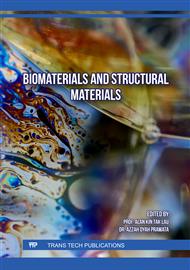[1]
William E. Garrett Jr., Md, Marc F. Swiontkowski, Md, James N. Weinstein, Do, Ms, John Callaghan, Md, Randy N. Rosier, Md, Phd, Daniel J. Berry, Md, John Harrast, Phd, G. Paul Derosa, Md, And The Research Committee Of The American Board Of Orthopaedic Surgery, "forum American Board of Orthopaedic Surgery Practice of the," p.660–668, 2006.
DOI: 10.1212/wnl.0000000000011524
Google Scholar
[2]
Aksakal, B., Ö. S. Yildirim, and H. Gul, "Metallurgical failure analysis of various implant materials used in orthopedic applications," J. Fail. Anal. Prev., vol. 4, no. 3, p.17–23, 2004.
DOI: 10.1361/15477020419794
Google Scholar
[3]
Yusuf, Yusril., Dyah Uswatun Khasanah, Firda Yanuar Syafaat, Ishak Pawarangan, Mona Sari, Vicky Julius Mawuntu dan Yazida Rizkayanti, " Biogenic Based Hydroxyapatite ", Gadjah Mada University Press, 2019, IKAPI 2875.116.08.19
Google Scholar
[4]
Januariyasa, I. Komang., and Y. Yusuf, "Synthesis of Carbonated Hydroxyapatite Derived from Snail Shells (Pilla ampulacea): Effect of Carbonate Precursor to the Crystallographic Properties," IOP Conf. Ser. Mater. Sci. Eng., vol. 546, no. 4, 2019.
DOI: 10.1088/1757-899X/546/4/042015
Google Scholar
[5]
Meiyasa, F., and N. Tarigan, " Utilization of Tuna Fish Bone Waste (Thunnus sp.) As a Source of Calcium in Making Seaweed Sticks," J. Teknol. Pertan. Andalas, vol.24, no. 1, p.67–76, 2020.
Google Scholar
[6]
Mutmainnah, M., S. Chadijah, and W. O. Rustiah, " Hydroxyapatite from Yellowfin Tuna (Tunnus albacores) Bones with Precipitation Method," Al-Kimia, vol. 5, no. 2, p.119–126, 2017.
DOI: 10.24252/al-kimia.v5i2.3422
Google Scholar
[7]
S. Chernousova, M. Epple, and M. Epple, "Bioactive bone substitution materials," Adv. Biomater. Devices Med., vol. 1, p.74–87, 2014.
Google Scholar
[8]
Yin, H. M.., et al., "Engineering porous poly(lactic acid) scaffolds with high mechanical performance via a solid state extrusion/porogen leaching approach," Polymers (Basel)., vol. 8, no. 6, 2016.
DOI: 10.3390/polym8060213
Google Scholar
[9]
Butylina, S., S. Geng, and K. Oksman, "Properties of as-prepared and freeze-dried hydrogels made from poly(vinyl alcohol) and cellulose nanocrystals using freeze-thaw technique," Eur. Polym. J., vol. 81, p.386–396, 2016.
DOI: 10.1016/j.eurpolymj.2016.06.028
Google Scholar
[10]
Habibovic, P., et al., "Comparison of two carbonated apatite ceramics in vivo," Acta Biomater., vol. 6, no. 6, p.2219–2226, 2010.
DOI: 10.1016/j.actbio.2009.11.028
Google Scholar
[11]
Januariyasa, I. K., I. D. Ana, and Y. Yusuf, "Nanofibrous poly(vinyl alcohol)/chitosan contained carbonated hydroxyapatite nanoparticles scaffold for bone tissue engineering," Mater. Sci. Eng. C, vol. 107, no. March 2019, p.110347, 2020.
DOI: 10.1016/j.msec.2019.110347
Google Scholar
[12]
Mourya, V. K., and N. N. Inamdar, "Chitosan-modifications and applications: Opportunities galore," React. Funct. Polym., vol. 68, no. 6, p.1013–1051, 2008.
DOI: 10.1016/j.reactfunctpolym.2008.03.002
Google Scholar
[13]
Merry, J. C., I. R. Gibson, S. M. Best, and W. Bonfield, "Synthesis and characterization of carbonate hydroxyapatite," J. Mater. Sci. Mater. Med., vol. 9, no. 12, p.779–783, 1998.
DOI: 10.1023/A:1008975507498
Google Scholar
[14]
Luque, P. L., M. B. Sanchez-Ilárduya, A. Sarmiento, H. Murua, and H. Arrizabalaga, "Characterization of carbonate fraction of the Atlantic bluefin tuna fin spine bone matrix for stable isotope analysis," PeerJ, vol. 2019, no. 7, p.1–15, 2019.
DOI: 10.7717/peerj.7176
Google Scholar
[15]
Esposti, L. Degli., et al., "Thermal crystallization of amorphous calcium phosphate combined with citrate and fluoride doping: a novel route to produce hydroxyapatite bioceramics," J. Mater. Chem. B, vol. 9, no. 24, p.4832–4845, 2021.
DOI: 10.1039/d1tb00601k
Google Scholar
[16]
Basu, B., and S. Ghosh, "Case Study: Hydroxyapatite Based Microporous/Macroporous Scaffolds," p.45–72, 2017.
DOI: 10.1007/978-981-10-3017-8_3
Google Scholar
[17]
Yang, W.H., X. F. Xi, J. F. Li, and K. Y. Cai, "Comparison of crystal structure between carbonated hydroxyapatite and natural bone apatite with theoretical calculation," Asian J. Chem., vol. 25, no. 7, p.3673–3678, 2013.
DOI: 10.14233/ajchem.2013.13709
Google Scholar
[18]
Chen, F., et al., "Hydroxyapatite nanorods/poly(vinyl pyrolidone) composite nanofibers, arrays and three-dimensional fabrics: Electrospun preparation and transformation to hydroxyapatite nanostructures," Acta Biomater., vol. 6, no. 8, p.3013–3020, 2010.
DOI: 10.1016/j.actbio.2010.02.015
Google Scholar
[19]
Dorozhkin, S. V., "Calcium orthophosphates in nature, biology and medicine," Materials (Basel)., vol. 2, no. 2, p.399–498, 2009.
DOI: 10.3390/ma2020399
Google Scholar
[20]
El-aziz, A. M. Abd., A. El-Maghraby, and N. A. Taha, "Comparison between polyvinyl alcohol (PVA) nanofiber and polyvinyl alcohol (PVA) nanofiber/hydroxyapatite (HA) for removal of Zn2+ ions from wastewater," Arab. J. Chem., vol. 10, no. 8, p.1052–1060, 2017.
DOI: 10.1016/j.arabjc.2016.09.025
Google Scholar
[21]
Permatasari, H.A., R. Wati, R. M. Anggraini, A. Almukarramah, and Y. Yusuf, "Hydroxyapatite extracted from fish bone wastes by heat treatment," Key Eng. Mater., vol. 840 KEM, p.318–323, 2020.
DOI: 10.4028/www.scientific.net/kem.840.318
Google Scholar
[22]
Mawuntu, V. J. and Y. Yusuf, "Porous structure engineering of bioceramic hydroxyapatite-based scaffolds using PVA, PVP, and PEO as polymeric porogens," J. Asian Ceram. Soc., vol. 7, no. 2, p.161–169, 2019.
DOI: 10.1080/21870764.2019.1595927
Google Scholar
[23]
Ma, P., W. Wu, Y. Wei, L. Ren, S. Lin, and J. Wu, "Biomimetic gelatin/chitosan/polyvinyl alcohol/nano-hydroxyapatite scaffolds for bone tissue engineering," Mater. Des., vol. 207, p.109865, 2021.
DOI: 10.1016/j.matdes.2021.109865
Google Scholar
[24]
Sari, M., Aminatun, T. Suciati, Y. W. Sari, and Y. Yusuf, "Porous carbonated hydroxyapatite‐based paraffin wax nanocomposite scaffold for bone tissue engineering: A physicochemical properties and cell viability assay analysis," Coatings, vol. 11, no. 10, 2021.
DOI: 10.3390/coatings11101189
Google Scholar
[25]
Charlena, I. H. Suparto, and D. K. Putri, "Synthesis of Hydroxyapatite from Rice Fields Snail Shell (Bellamya javanica) through Wet Method and Pore Modification Using Chitosan," Procedia Chem., vol. 17, p.27–35, 2015.
DOI: 10.1016/j.proche.2015.12.120
Google Scholar
[26]
Beh, C. Y. et al., "Morphological and optical properties of porous hydroxyapatite/cornstarch (HAp/Cs) composites," J. Mater. Res. Technol., vol. 9, no. 6, p.14267–14282, 2020.
DOI: 10.1016/j.jmrt.2020.10.012
Google Scholar



